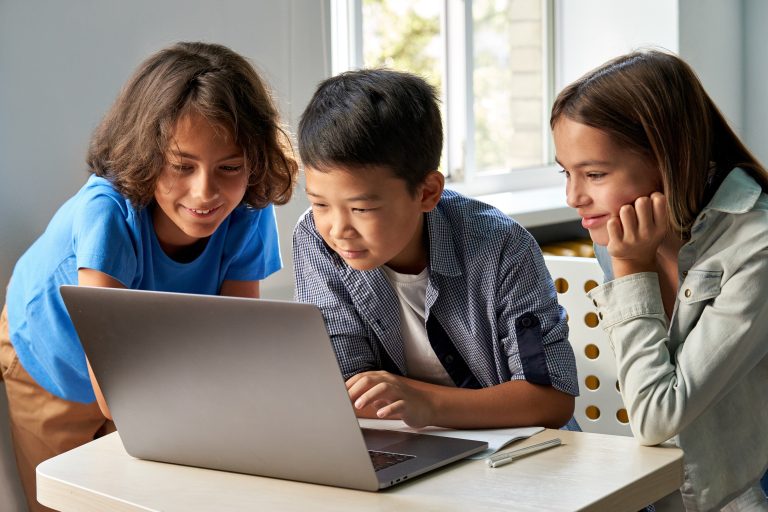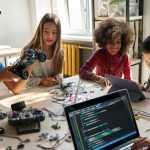As educators we can agree that providing equal and equitable access to learning is a priority. But making this happen can be challenging when we consider the variety of students we teach. Students come into our classrooms with different backgrounds, personal needs, and preferences.
How can educators meet students’ varied needs while also meeting standards and not become overwhelmed?
We can meet these needs by using the Universal Design for Learning (UDL) framework to drive our instruction. “UDL is a framework to guide the design of learning environments that are accessible and challenging for all” (cast.org). At its core, the UDL framework and guidelines strive to identify and break down barriers to learning and empower students to become expert learners.
When we pair UDL with effective educational technology tools, the opportunities for accessible learning experiences are limitless. But which of the many edtech tools should we choose? What should we look for when picking digital resources to use with our students?
Let’s use the 3 principles for UDL as our guide:
Engagement
The first principle of UDL – Multiple Means of Engagement – focuses on providing options for “recruiting interest,” “sustaining effort and persistence,” and “self-regulation.” But what does that mean when we think about creating accessible digital learning experiences for students?
For me, it means looking for digital tools that will support “one stop shop” learning. Teachers and students have access to so many tools and resources, which can be wonderful, but when we use too many tools at once students can be easily distracted or overwhelmed. So, we need to look for tools that nurture student curiosity and drive student engagement (with the content, the teacher and each other) in one place.
One stop shop learning starts with a learning management system which launches students directly into digital platforms where students can participate in self-contained interactive lessons such as Pear Deck or Lumio. Another great option is Discovery Education, which is offered at no cost to schools in South Carolina by our State Department of Education. With comprehensive K-12 platforms, teachers can create a single resource for a lesson and insert content in a variety of ways including audio and video. Students stay on one platform to complete interactive questions and collaborate with students and the teacher. Teachers can even embed opportunities for student self-assessment and reflection.
I find that staying on one platform does not diminish the variety or creativity of a lesson, but instead helps reduce distractions and frustrations with learning many new tools. All of these factors help improve students’ persistence and achievement.
Representation
The second principle of UDL – Multiple Means of Representation – focuses on building students who are resourceful and knowledgeable. This is the principle that guides teachers to create instructional materials and choose digital resources that allow students to learn in a variety of ways: auditory, visual, multiple media, etc.
When I design a lesson, I think of possible barriers my students might encounter when accessing the learning (language barriers, limited background knowledge, visual or auditory issues, etc.). I choose tools that will help address those barriers, not only for the students with documented needs, but for all students. Tools that allow students options in how they access information help empower students to become expert learners.
One of the key tools I look for is the integration of Immersive Reader. With Immersive Reader, students can have text read aloud, change the pace of the audio, change fonts, change the size and color of the text, translate text, and use a picture dictionary. The one stop shop platforms mentioned above have Immersive Reader built in. Other tools, like Flip and Wakelet also integrate Immersive Reader. Immersive Reader allows students to overcome barriers and make their own choices in how they read.
In addition, when we use tools embedded with Immersive Reader, we do not have to spend extra time redesigning lesson materials for different students. We are empowering all students to use the tools that work for them while saving teachers’ time: a win-win!
Action and Expression
The final UDL principle – Multiple Means of Action & Expression – focuses on providing students options in how they show what they know. This principle also addresses students’ executive functioning with the goal of them becoming strategic and goal directed.
Choice is an essential element of UDL. When looking at resources that support accessible learning opportunities, we need to find tools that offer students more than one way to show what they know.
For example, students in a Modern World History class need to “Summarize how major world revolutions created new global affairs and interactions” (SC Standard MWH.2.CE). The standard doesn’t say they have to write a paper to show their understanding. So, we want to choose tools that allow students to respond in a variety of ways: write, speak, visualize, etc. while still being accessible and easy to use.
Some of my favorite tools for having students create and demonstrate their learning include Flip, Kami, and the core Google Tools. Students can record videos and use text to speech options. Kami is also a useful tool for full accessibility options since it will read text aloud to students and allows students and teachers to insert comments in a variety of ways (text, voice, video, and screen capture). These tools also help with the one stop shop goal since teachers’ directions and students’ responses can all be contained within the same file.
Keeping the three principles of UDL in mind will help educators sort through the many digital options available and choose a few core tools that will best meet the needs of all students. By doing so, we can ensure that all students have accessible learning opportunities.
Susan Aplin is the Instructional Technology Specialist in South Carolina’s School District Five of Lexington & Richland Counties.
Discovery Education is the worldwide edtech leader whose state-of-the-art digital platform supports learning wherever it takes place. Through its award-winning multimedia content, instructional supports, and innovative classroom tools, Discovery Education helps educators deliver equitable learning experiences engaging all students and supporting higher academic achievement on a global scale. Discovery Education serves approximately 4.5 million educators and 45 million students worldwide, and its resources are accessed in over 100 countries and territories. Inspired by the global media company Warner Bros. Discovery, Inc. Discovery Education partners with districts, states, and trusted organizations to empower teachers with leading edtech solutions that support the success of all learners. Explore the future of education at DiscoveryEducation.com.
- Discovery Educationhttps://ace-ed.org/author/discoveryeducation/
- Discovery Educationhttps://ace-ed.org/author/discoveryeducation/
- Discovery Educationhttps://ace-ed.org/author/discoveryeducation/
- Discovery Educationhttps://ace-ed.org/author/discoveryeducation/November 9, 2024






